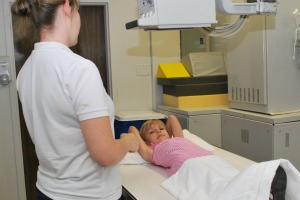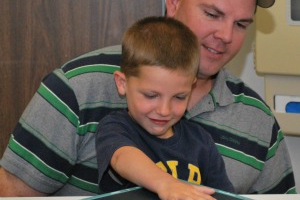General Diagnostic X-Ray
Chest X-Ray
The radiology technologist will take you to an X-ray room, where there will be a big table and a camera. If you are wearing a shirt that has buttons, zippers, or sparkles on it, you will be asked to remove it so the X-ray machine can take a picture of the inside of your chest. If your shirt is plain and does not have buttons, zippers, or sparkles on it, you may leave it on.
To take the picture, you will be asked to put your chest up against a board. The radiology technologist will take two pictures, one of you standing close to the board and one of you standing with the board on your side. It’s your job to stand very still. When the technologist takes the pictures, you will hear a buzz and then a beep. That’s it! You are all done.
A radiologist is a type of doctor who looks at the pictures and tells your primary doctor what he or she sees. Your doctor should have the results within 24 to 48 hours.
Abdomen (Stomach) X-Ray
 The radiology technologist will take you to an X-ray room, where there will be a big table and a camera. For most abdomen (stomach) X-rays, you will be asked to put on a hospital gown so the X-ray machine can take a picture of the area around your stomach.
The radiology technologist will take you to an X-ray room, where there will be a big table and a camera. For most abdomen (stomach) X-rays, you will be asked to put on a hospital gown so the X-ray machine can take a picture of the area around your stomach.
After putting a gown on, you will be asked to lie on the table. The radiology technologist will shine a light on your stomach showing the area he or she will take a picture of. It’s your job to stand very still. When the technologist takes the pictures, you will hear a buzz and then a beep. That’s it! You are all done.
A radiologist is a type of doctor who looks at the pictures and tells your primary doctor what he or she sees. Your doctor should have the results within 24 to 48 hours.
Extremities (Arms and Legs) X-Ray
 Extremities are the parts of your body that extend from your chest and abdomen. These include your arms and legs.
Extremities are the parts of your body that extend from your chest and abdomen. These include your arms and legs.
The radiology technologist will take you to an X-ray room, where there will be a big table and a camera. You will be asked to place the appropriate extremity on a cassette. A cassette is a board where the image is stored until it is processed. The radiology technologist will shine a light on it showing the area he or she will take a picture of. When the technologist takes the pictures you will hear a buzz and then a beep. That’s it! You are all done.
A radiologist is a type of doctor who looks at the pictures and tells your primary doctor what he or she sees. Your doctor should have the results within 24 to 48 hours.
